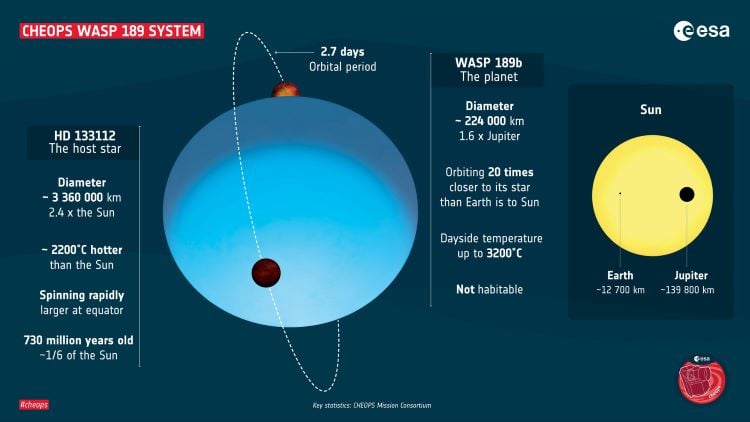A recent study presented this week at the 2023 meeting of the American Geophysical Union discusses observations of “hot Jupiters” from the NASA-funded CubeSat mission known as the Colorado Ultraviolet Transit Experiment (CUTE). Unlike most exoplanet-hunting telescopes, whose sizes are comparable to a small school bus, CUTE measures 36 centimeters (14 inches) in length, equivalent to the size of a cereal box. These findings come after members of the team, which consists of undergraduate and graduate students, published an overview paper about CUTE in The Astronomical Journal* in January 2023 and results from CUTE observing WASP-189b in The Astrophysical Journal Letters* in August 2023.
Launched in September 2021, CUTE has focused its ultraviolet capabilities on several hot Jupiters to better understand the atmospheric escape that occurs on these worlds since they orbit so close to their parent stars. For example, WASP-189b has an orbital period of 2.7 days, which is a fraction of the 88 days that Mercury, the innermost planet in our solar system, takes to orbit our Sun. For that study, the team used CUTE to identify that WASP-189b was having its atmosphere escape at a mind-blowing rate of 400 million kilograms (882 million pounds) per second due to its scorching surface temperatures of approximately 8,315 degrees Celsius (15,000 degrees Fahrenheit).
Video published days before the launch of CUTE in September 2021 discussing the mission and its goals.Additionally, with WASP-189b being located about 325 light-years from Earth, this demonstrates CUTE's incredible observational capabilities despite its small size. Using CUTE, which is currently orbiting 525 kilometers (326 miles) above Earth's surface, astronomers hope to gain greater insight into the formation and evolution of planets outside our solar system.
"We want to understand how our solar system fits into the family of solar systems in the universe," said Dr. Kevin France, who is the CUTE Principal Investigator, an associate professor in the Department of Astrophysical and Planetary Sciences at CU Boulder, lead author of the overview paper, and co-author on the WASP-189b paper. "That means understanding the big planets, the small planets, the ones that could have life and the ones that definitely don't—and all of the important physical processes that are operating on these planets."
While WASP-189b is likely the most promising example of CUTE's incredible capabilities, the CUTE team has observed a total of seven hot Jupiters, with some results more exciting than others. For example, the team observed MASCARA-4b, which is located approximately 557 light-years from Earth, and KELT-9b, which is located approximately 667 light-years from Earth, with the team finding barely any gas escaping and "somewhere in the middle", respectively. However, atmospheric escape isn't limited to only hot Jupiters, as better understanding this phenomenon could help astronomers better understand the evolution of “super-Earths”, as well.
"There's a lot of evidence that suggests that super Earths begin as planets the size of Neptune with large, puffy atmospheres, which then lose so much mass that all that is left is the rocky core and possibly a thin atmosphere," said Dr. France.
Despite its promise to teach astronomers more about hot Jupiters and escaping atmospheres, the time to use CUTE is limited, as it is currently scheduled to re-enter the Earth's atmosphere sometime in 2027.
What else will CUTE teach astronomers about hot Jupiters and atmospheric escape in the next few years, and what new insights will astronomers learn about these unique worlds in the coming years and decades? Only time will tell, and this is why we science!
As always, keep doing science & keep looking up!
 Universe Today
Universe Today

